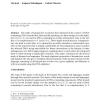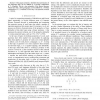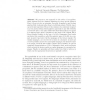8 search results - page 1 / 2 » The syntactic monoid of hairpin-free languages |
DAM
2007
13 years 4 months ago
2007
We use syntactic monoid methods, together with an enhanced pumping lemma, to investigate the structure of splicing languages. We obtain an algorithm for deciding whether a regular...
ACTA
2007
13 years 5 months ago
2007
The study of hairpin-free words has been initiated in the context of DNA computing. DNA strands that, theoretically speaking, are finite strings over the alphabet {A, G, C, T} are...
DLT
2003
13 years 6 months ago
2003
We continue our investigation on the relationship between regular languages and syntactic monoid size. In this paper we confirm the conjecture on two generator transformation semi...
LICS
2008
IEEE
13 years 11 months ago
2008
IEEE
— This paper presents a decidable characterization of tree languages that can be defined by a boolean combination of Σ1 formulas. This is a tree extension of the Simon theorem,...
ICALP
2010
Springer
13 years 9 months ago
2010
Springer
We propose a new approach to the notion of recognition, which departs from the classical definitions by three specific features. First, it does not rely on automata. Secondly, it...



